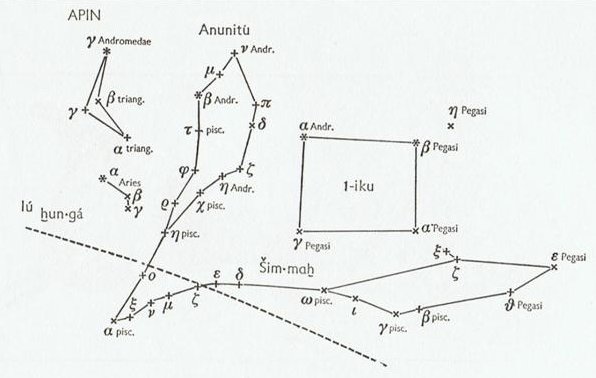6. Once the vajra was a kind of fist-iron and iron is a sign of Mars. Like other metals you have to dig for it and they originate from inside Mother Earth. Even when iron is delivered from the sky in form of a meteorite it can burrow itself into the earth. Metallah is α Triangulum and the triangular form of this constellation is similar to the V-form of the Hyades (like the Roman 5 and the hand sign for victory of Winston Churchill):
With an iron plow as a 'weapon' it is much easier to work the fields. The Babylonian constellation Mul-Apin was a plow: 
Therefore I guess the object which the returning Sun King (Pharaoh) in ancient Egypt had in his left hand refers to an instrument which allowed him to reopen the land, to make it fruitful: ... When he reappears he is clothed as in the Narmer palette, wearing the kilt with Hathor belt and bull's tail attatched. In his right hand he holds the flail scepter and in his left, instead of the usual crook of the Good Shepherd, an object resembling a small scroll, called the Will, the House Document, or Secret of the Two Partners, which he exhibits in triumph, proclaiming to all in attendance that it was given him by his dead father Osiris, in the presence of the earth-god Geb. 'I have run', he cries, 'holding the Secret of the Two Partners, the Will that my father has given me before Geb. I have passed through the land and touched the four sides of it. I traverse it as I desire.' Pharaoh held 'the will' in his left hand because in ancient Egypt all was done contrary to the normal way. Vajrasattva has his in his right hand and in his left he has a bell:
Clearly the Secret of the Two Partners gave Pharaoh command over all land. And clearly the pou glyph at the beginning of the front side of G is drawn to show a kind of pair joined into a single unit (like a pair of oxen):
The pair which are joined could represent the pair of 'years' (summer and winter), or in a more general way they could be 'male' and 'female' ('cap' and 'cup', Sun and Moon, fire and water, up and down, 1 and 2, etc). In ancient Egypt the union of Upper with Lower Egypt would have been a natural allusion. A vajra has two 'crowns', one at each end, and Osiris was a Moon God. In G the puo signs of Hyades show integrity but in K the bottom part is not visible - 'Lower Egypt' is not there. The lower part of the cycle (which needs twice π to be measured in full) is not documented on the K tablet:
The text on the K tablet has only 5 + 5 = 10 glyph lines. It has no back side, no Moon side. |



